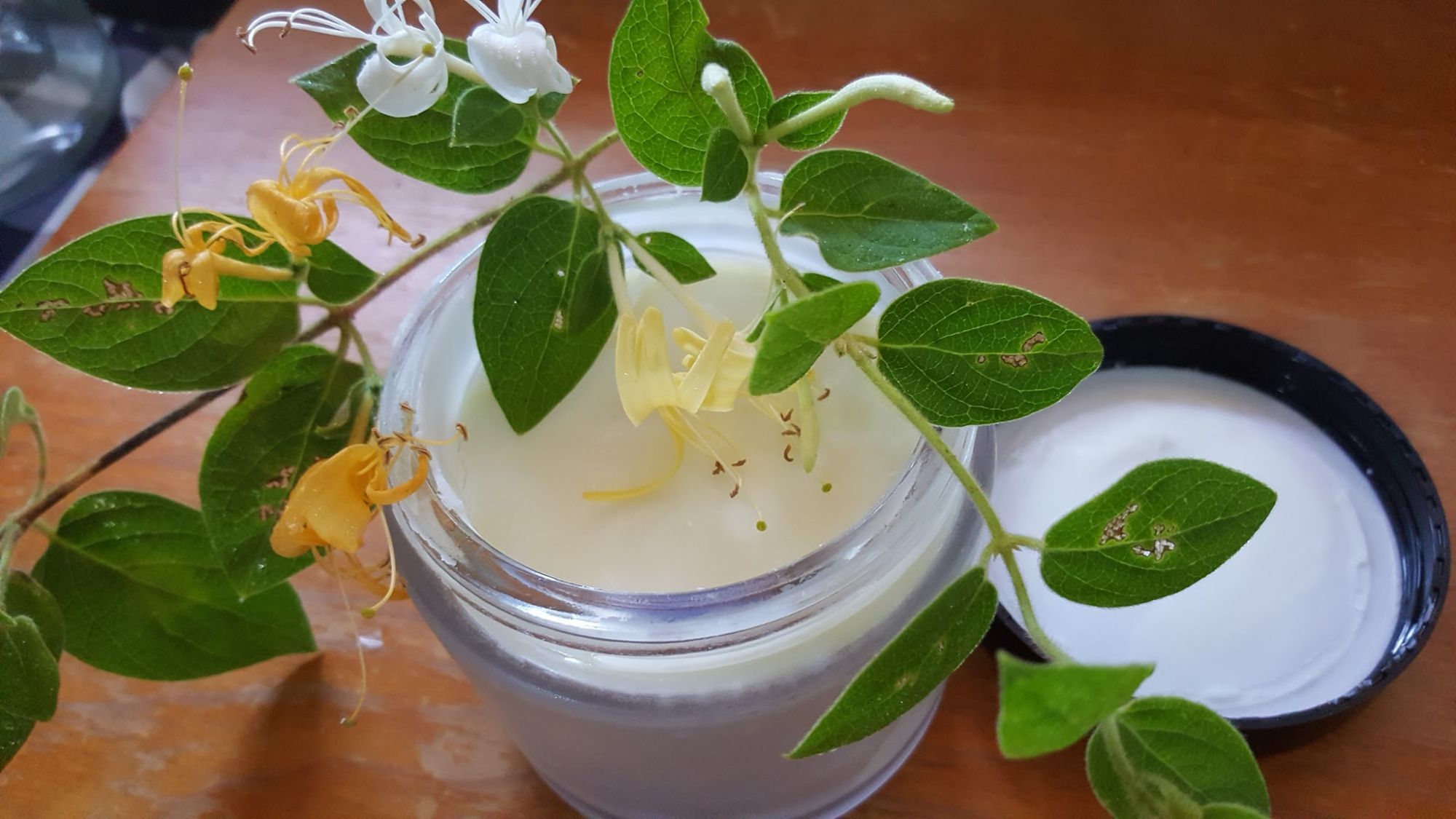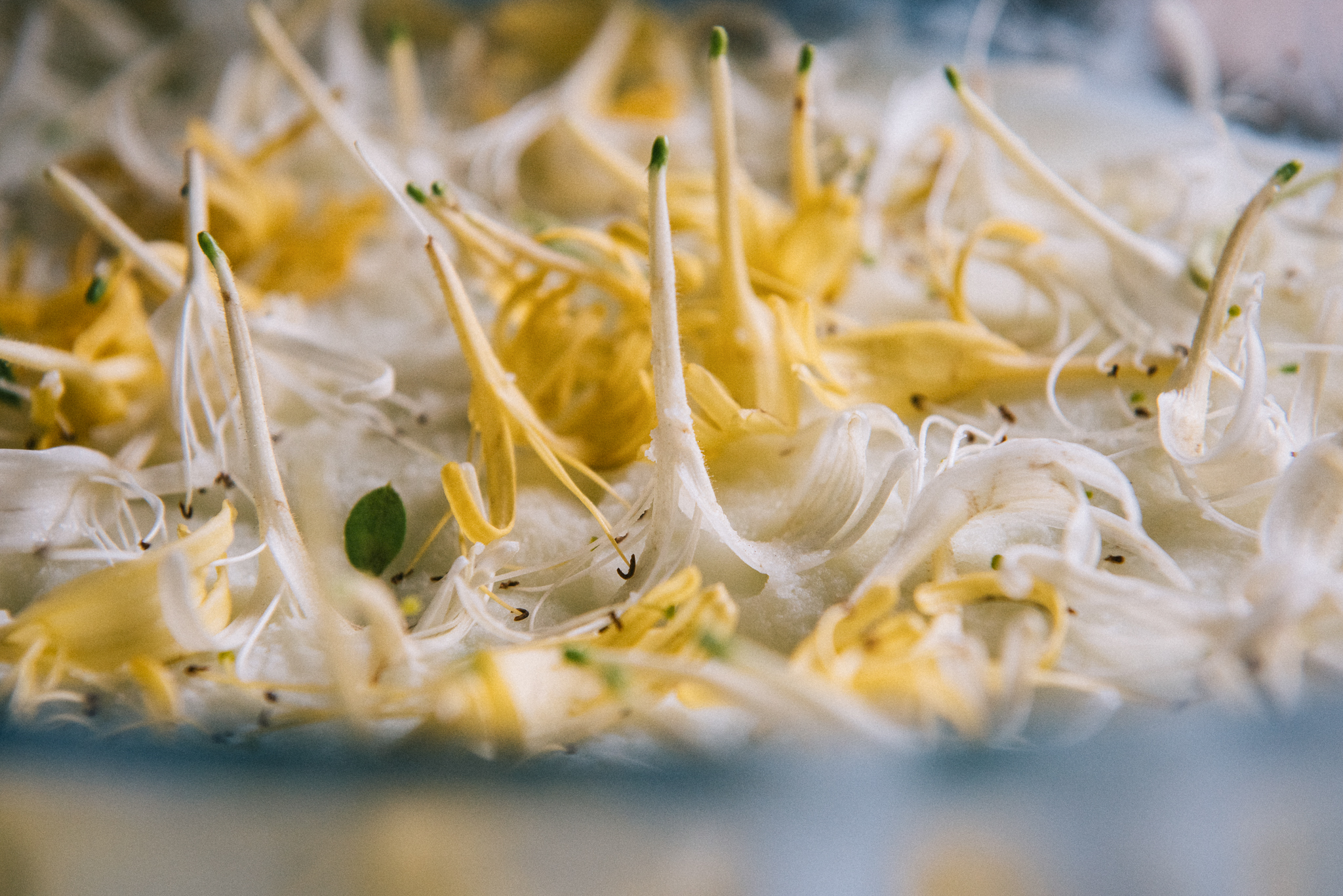
Freesia, honeysuckle, jasmine, white ginger, gardenia, and orange blossom—all highly fragrant, creamy white flowers containing a magic chemical compound known as ‘indol.’ Indolic flowers are intriguing. In fact, the whole notion of indolism is intriguing. On a purely subjective level, the meaning of ‘indolic’ could be thought about and visualised like this:
Start by imagining that you are out walking on a warm, late spring day. The kind of day that is sunny and dry, but not so dry that all the moisture has been robbed from the ground. See yourself cutting a path between coast and bush. As you walk, you’re suddenly hit by the combined scent of wild, roaming honeysuckle and jasmine, and then a hint, just a hint, of a decaying animal somewhere further afield.
This polarity, this yin and yang combination, is what makes indolic flowers so fascinating. At first floral, sweet and heady, but also, earthy, fecund, a little disgusting, and very very sexy. Indolic flowers are utterly intoxicating and a reminder of the universal passage of time. Birth, sex, death—it’s all there, even in the most common flowering ‘weeds’.
Perfumer, Mandy Aftel states that ‘the heavy florals have an intensely narcotic aura. They induce a sense of receptivity and surrender, almost of being ravished. After working with them for a while I feel as if I have been drugged.’ (Essence & Alchemy: A Natural History of Perfume, 2008). As we head into a cold and introspective winter, it’s worth from time to time, recalling the sparkle of spring days, the blessing of white perfumed flowers and of course the first whiff of indol.
From a distiller of aromatics standpoint, attempts to capture and synthesize indol mostly fail. Indol on its own loses its magic when removed from its natural setting. But for those fascinated by botanicals and the natural extraction of aroma, there is always a way!
Here is a simple method called ‘enfleurage’ that you can use at home to capture a little bit of the magic of indol with just two simple ingredients.
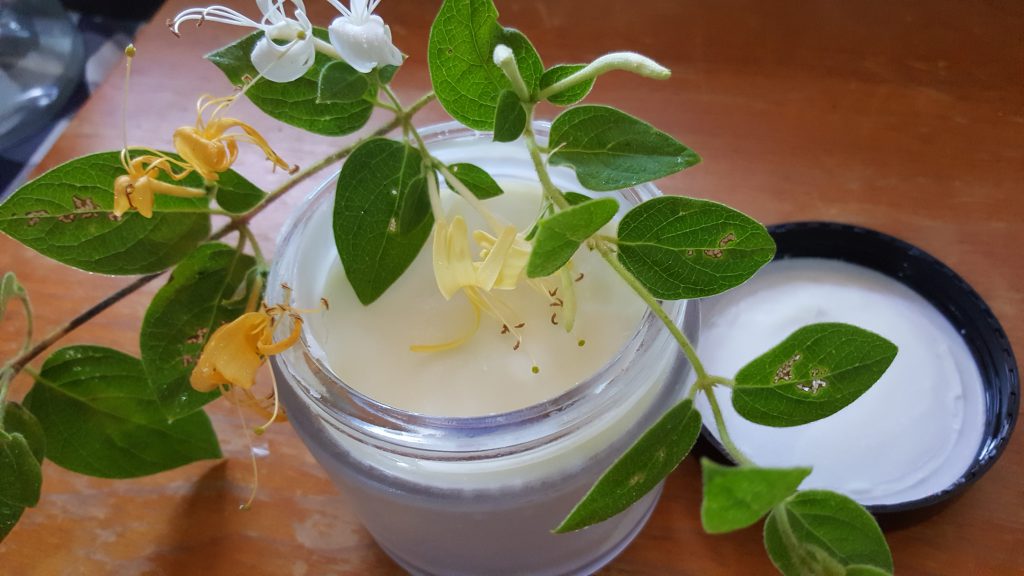
Honeysuckle Pomade
The Art of Enfleurage
We suggest starting your first enfleurage with honeysuckle, jasmine or white ginger. Commonly considered weeds, these flowers can generally be found growing wild and abundantly in most parts of New Zealand.
Honeysuckle generally flowers from April through to October, making it one of the most accessible indolic flowers. Jasmine has a more restricted season tending to bloom from August through to October annually. Finally, white ginger blooms in the summer months, but depending on climate and weather conditions may continue to flower right through to early June!
Here is a little more information about each flower:
Japanese Honeysuckle – Lonicera japonica
An invasive, flowering vine species native to Japan, Japanese Honeysuckle can be found throughout the North and South Island of New Zealand. The small plain white and yellow flowers are somewhat deceiving, with their distinctive double-tongue, they exude a surprising strength of sweet, honeyed fragrance.
Jasmine – Jasminum polyanthum
Commonly known as white and pink jasmine, this variety grows throughout New Zealand, and has long been considered an invasive weed for its tendency to strangle native plants and restrict sapling growth. A native of China, it produces an abundance of tiny pink buds, which open into pure white star-shaped flowers in spring, exuding the most delightful, indolic perfume.
White Ginger – Hedychium coronarium
Commonly called lily or garland flower, white ginger is a native of tropical Asia. A rhizomatous perennial, white ginger grows well in the sub-tropical New Zealand climate, particularly in the North Island. Featuring large, lance-shaped green leaves and beautiful fragrant white flowers, white ginger blooms work particularly well for novice enfleuragers.
Enfleurage Instructions
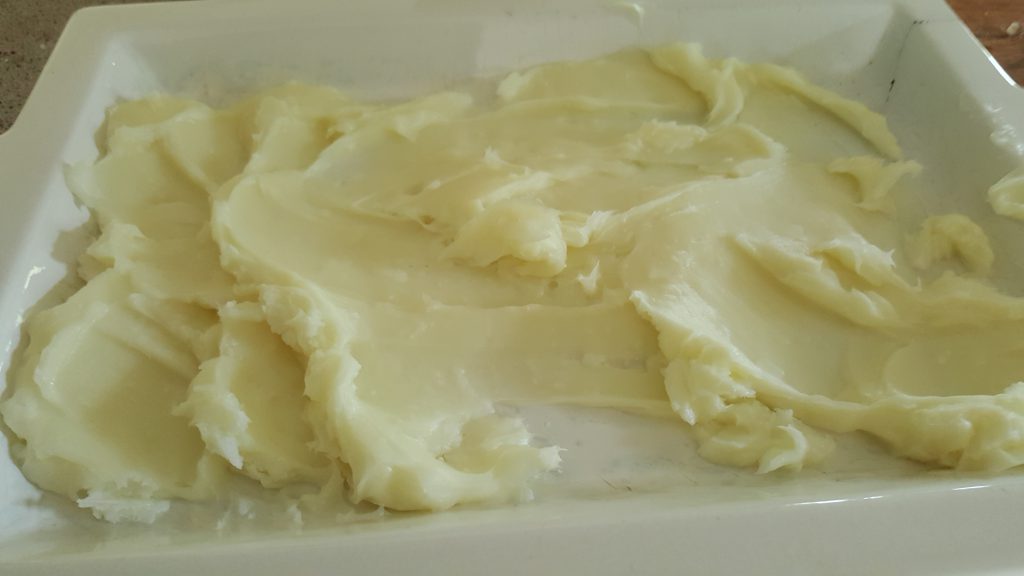
Palm Oil
- Start with a clean, shallow glass baking dish. A classic Pyrex works very well, and can easily be found in supermarkets and op shops.
- Select a fat that stays solid at room temperature and has no aroma. Traditionally, enfleurage required a rendered animal fat, however, you may substitute this with organic palm oil or She butter.
- Cover the surface of your glass dish with fat, and then place in a moderate oven so the fat melts and spreads evenly in the dish.
- Remove as soon as the fat has melted, cover and allow to cool and become solid. You should have a 15ml layer of even fat to work with.
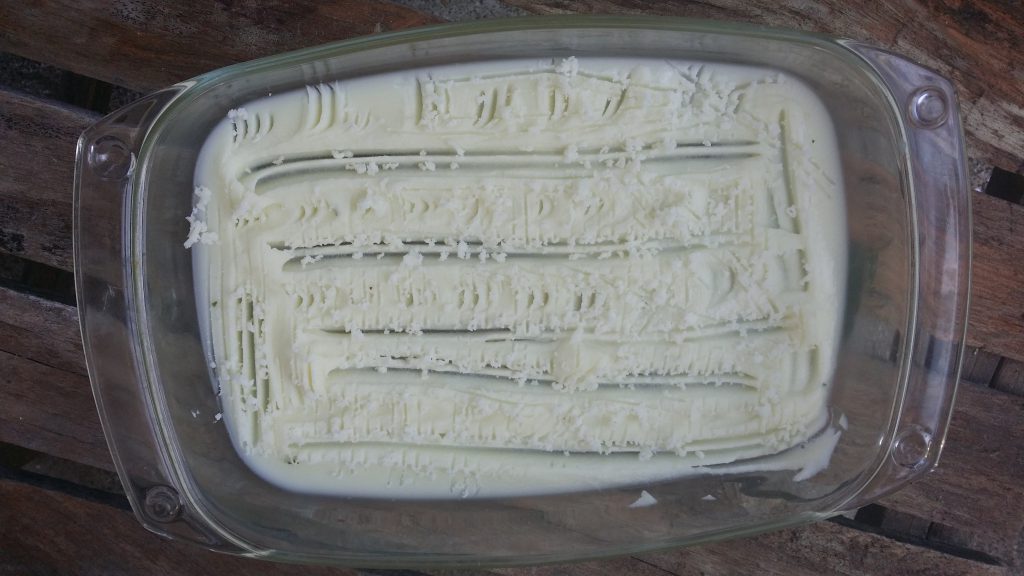
Scored Palm Oil
- Score the now solid fat in a criss-cross pattern with a fork.
- Pick your chosen flowers when they are releasing their aroma. Honeysuckle exudes more perfume in the dimming light, so picking them at twilight is best. Jasmin is best picked at night, while white ginger has such a robust aroma it can be picked throughout the day and early evening.
- Make sure that your flowers are fresh and dry, and not covered in dew. Place the flowers face down on the surface of the fat so they breath into it. The tiny volatile aromatic molecules land on the fat and dissolve impregnating it with perfume.
-
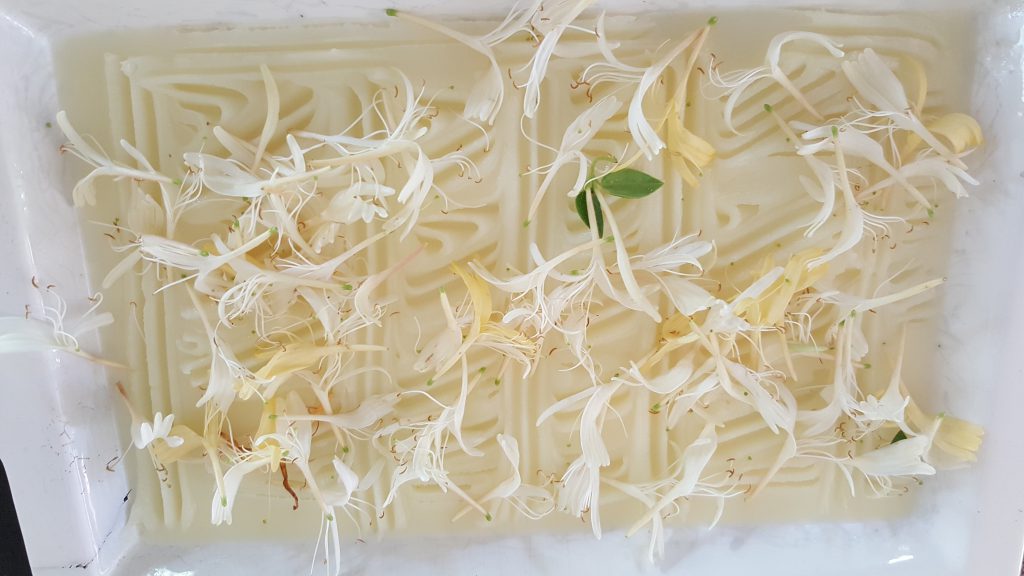
Honeysuckle flowers
Leave for the 24 hours, and then using tweezers carefully remove the old flowers and replace with freshly picked ones.
- Try not to have the flowers overlapping or touching as this can create places for mold to grow.
- Repeat this up to 20 times. The more you refresh the flowers the more saturated with aroma the fat will become.
- When you are happy with the intensity of aroma, place the fat in a double boiler and heat VERY gently until it melts.
- Pour the melted fat through a fine strainer or jelly bag into a clean glass jar and refrigerate. This is called a Pomade. You can use this as a cream perfume or add to moisturizer and body lotions.
To learn more about these age old techniques – come to an Alembics workshop
Happy enfleuraging from the team at Alembics!

